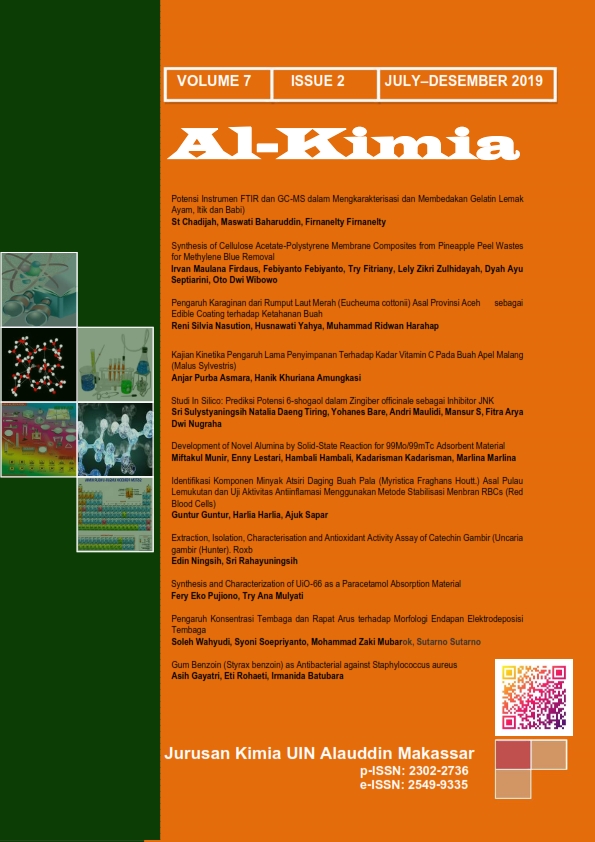Studi In Silico: Prediksi Potensi 6-shogaol dalam Zingiber officinale sebagai Inhibitor JNK
Abstract
Type 2 Diabetes Mellitus (T2DM) is a metabolic disease characterized by hyperglycemia and insulin resistance. T2DM therapy against c-Jun N-terminal kinase (JNK) is one of the recovery solutions using bioactive compounds from ginger. 6-shogaol is bioactive compounds of ginger that has antioxidant properties. The purpose of this study is to analyze the potential of 6-shogaol as a JNK inhibitor. JNK protein (ID: 464Y) was obtained from Protein Data Bank (PDB) through 6-shogaol ligand (CID: 5281794) obtained from the PubChem database. Protein docking protein and ligand use Hex 8.0.0 software while visualization and analysis using Discovery Studio client 4.0. The results showed that 6-shogaol was predicted to have potential as a JNK inhibitor. Proving this by finding five amino acid residues (TRY223, LEU210, THR103 ALA214, ARG107) with an energy of -236.29cal/mol. We found the type of hydrogen bonds and the van der waals forces formed. The interaction of ligand and protein successfully inactivates JNK and stops pancreatic β cell dysfunction. 6-shogaol has pharmacological properties as a JNK,T2DM.
Downloads
References
Bare, Y., Elizabeth, A., Sari, D. R. T., Rachmad, Y. T., Krisnamurti, G. C., & Lorenza, M. R. W. G. (2019). The potential role of caffeic acid in coffee as cyclooxygenase-2 (COX-2) inhibitor: In silico study. Biointerface Research in Applied Chemistry, 9(5), 4424–4427. https://doi.org/10.33263/BRIAC95.424427
Bare, Y., Kuki, A. D., Rophi, A. H., Krisnamurti, G. C., & Lorenza, Ma. W. W. G. (2019). Prediksi Asam Kuinat sebagai Anti-inflamasi terhadap COX-2 secara Virtual. Biota: Jurnal Imiah Ilmu-Ilmu Hayati, 4 (3).
Bare, Y., Marhendra, A., Sasase, T., & Fatchiyah, F. (2018). Differential Expression of IL-10 Gene and Protein in Target Tissues of Rattus Norvegicus Strain Wistar Model Type 2 Diabetes Mellitus (T2DM). Acta Informatica Medica, 26(2), 87. https://doi.org/10.5455/aim.2018.26.87-92
Bare, Y., Sari, D. R., Rachmad, Y. T., Tiring, S. S. N. D., Rophi, A. H., & Nugraha, F. A. D. (2019). Prediction Potential Chlorogenic Acid As Inhibitor Ace (In Silico Study). Bioscience, 3(2), 197. https://doi.org/10.24036/0201932105856-0-00
Cui, J., Zhang, M., Zhang, Y., & Xu, Z. (2007). JNK pathway: Diseases and therapeutic potential. Acta Pharmacologica Sinica, 28(5), 601–608. https://doi.org/10.1111/j.1745-7254.2007.00579.x
DeFronzo, R. A., Ferrannini, E., Groop, L., Henry, R. R., Herman, W. H., Holst, J. J., … Weiss, R. (2015). Type 2 diabetes mellitus. Nature Reviews Disease Primers, 1(1), 15019. https://doi.org/10.1038/nrdp.2015.19
Hardjono, S. (2013). Sintesis dan Uji Aktivitas Antikanker Senyawa 1-(2-KLOROBENZOILOKSI) Urea dan 1-(4-KLOROBENZOILOKSI) Urea. (1), 6.
Hirosumi, J., Tuncman, G., Chang, L., Görgün, C. Z., Uysal, K. T., Maeda, K., … Hotamisligil, G. S. (2002). A central role for JNK in obesity and insulin resistance. Nature, 420(6913), 333–336. https://doi.org/10.1038/nature01137
Kataria, R., & Khatkar, A. (2019). In-silico design, synthesis, ADMET studies and biological evaluation of novel derivatives of Chlorogenic acid against Urease protein and H. Pylori bacterium. BMC Chemistry, 13(1). https://doi.org/10.1186/s13065-019-0556-0
Kesuma, D., Siswandono, S., Purwanto, B. T., & Hardjono, S. (2018). Uji in silico Aktivitas Sitotoksik dan Toksisitas Senyawa Turunan N-(Benzoil)-N’- feniltiourea Sebagai Calon Obat Antikanker. JPSCR : Journal of Pharmaceutical Science and Clinical Research, 3(1), 1. https://doi.org/10.20961/jpscr.v3i1.16266
Mao, Q.-Q., Xu, X.-Y., Cao, S.-Y., Gan, R.-Y., Corke, H., Beta, T., & Li, H.-B. (2019). Bioactive Compounds and Bioactivities of Ginger (Zingiber officinale Roscoe). Foods, 8(6), 185. https://doi.org/10.3390/foods8060185
Olokoba, A. B., Obateru, O. A., & Olokoba, L. B. (2012). Type 2 Diabetes Mellitus: A Review of Current Trends. Oman Medical Journal, 27(04), 269–273.
Syamsurizal, S. (2018). Type-2 Diabetes Mellitus of Degenerative Disease. Bioscience, 2(1), 34. https://doi.org/10.24036/02018219980-0-00
Teng, H., Seuseu, K. T., Lee, W.-Y., & Chen, L. (2019). Comparing the effects of microwave radiation on 6-gingerol and 6-shogaol from ginger rhizomes (Zingiber officinale Rosc). PLOS ONE, 14(6), e0214893. https://doi.org/10.1371/journal.pone.0214893
Yarza, R., Vela, S., Solas, M., & Ramirez, M. J. (2016). C-Jun N-terminal Kinase (JNK) Signaling as a Therapeutic Target for Alzheimer’s Disease. Frontiers in Pharmacology, 6. https://doi.org/10.3389/fphar.2015.00321
Copyright (c) 2019 YOHANES BARE, SRI SULISTYANINGSI NATALIA DAENG TIRING

This work is licensed under a Creative Commons Attribution-NonCommercial-ShareAlike 4.0 International License.
Authors who publish with this journal agree to the following terms:
1) Authors retain copyright and grant the journal right of first publication with the work simultaneously licensed under a Creative Commons Attribution License that allows others to share the work with an acknowledgement of the work's authorship and initial publication in this journal.
2) Authors are able to enter into separate, additional contractual arrangements for the non-exclusive distribution of the journal's published version of the work (e.g., post it to an institutional repository or publish it in a book), with an acknowledgement of its initial publication in this journal.
3)Authors are permitted and encouraged to post their work online (e.g., in institutional repositories or on their website) prior to and during the submission process, as it can lead to productive exchanges, as well as earlier and greater citation of published work (See The Effect of Open Access).


